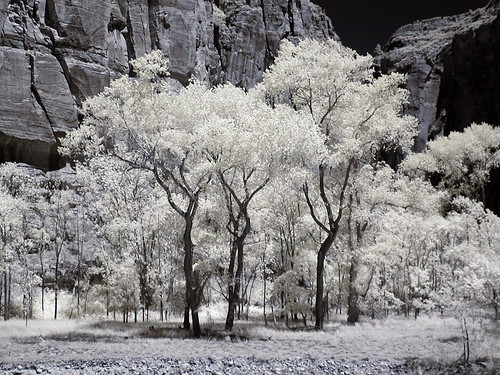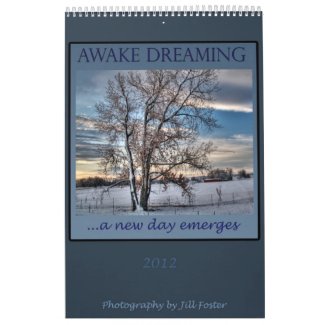
I'm channeling
Ansel today. This
shot is of trees along the Virgin River in
Zion National Park in Utah. I'd like to think that if Ansel Adams was around today, that he'd be shooting IR (infrared). Ansel was known for his landscapes in western national parks (especially Yosemite) and used sharp contrasts and depth of field. He, of course, shot with wide format cameras on film with long exposures and using a tripod, but I'd like to think that if had the option of infrared, he would have loved it. It is also little known that near the end of his life he also shot in color, which leads me to believe that he would have also used all the tools available to him, including HDR photography and digital cameras.
This shot was with my old Olympus, only 2.1 megapixil and non-DSL. The light was perfect and at this moment the wind was rustling so gave some of the leaves a bit of a feathery look while the higher leaves were more still and clearer.

 Both of these shots: The top is Quail Creek Canyon and the bottom is "Orson Adams House" are from the Red Cliffs National Recreation Area, outside of a small town called Leeds, about a half hour north of St. George. The cabin is from the original Mormon settlers of the area is on the road that leads up to the park. Quail Creek Canyon is a slot canyon that was about a mile from the park entrance, uphill through a sandy path in 100 degree heat. The best time to photograph slot canyons is noon since the light shines down most vertically illuminating the walls the best. The top picture was taken with my Nikon D70 and the bottom is from the Olympus 2020Z. Although the bottom picture looks a little sharper, the image size is jpeg only and is of a small file size so is not able to be enlarged significantly. The top image was shot in raw and then converted to duotone. The shutter speed is quite slow (since I didn't want to hike a tripod in as well) so not quite as sharp.
Both of these shots: The top is Quail Creek Canyon and the bottom is "Orson Adams House" are from the Red Cliffs National Recreation Area, outside of a small town called Leeds, about a half hour north of St. George. The cabin is from the original Mormon settlers of the area is on the road that leads up to the park. Quail Creek Canyon is a slot canyon that was about a mile from the park entrance, uphill through a sandy path in 100 degree heat. The best time to photograph slot canyons is noon since the light shines down most vertically illuminating the walls the best. The top picture was taken with my Nikon D70 and the bottom is from the Olympus 2020Z. Although the bottom picture looks a little sharper, the image size is jpeg only and is of a small file size so is not able to be enlarged significantly. The top image was shot in raw and then converted to duotone. The shutter speed is quite slow (since I didn't want to hike a tripod in as well) so not quite as sharp.




